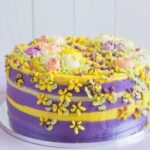Planning your cake decorations in advance is crucial for achieving a beautiful and stress-free result. Whether you are a professional baker or a home baker, understanding how far in advance you can decorate a cake is essential for proper time management and ensuring the freshness and quality of your creation.
Decorating a cake involves various elements such as the cake base, frosting, fillings, icing, fondant, intricate designs or shapes, finishing touches, and transportation. Each of these components requires careful consideration and planning to ensure they come together seamlessly.
One of the benefits of decorating a cake in advance is that it allows you to take your time to perfect each element without rushing at the last minute. Planning ahead also lets you address any unforeseen challenges or mistakes along the way without compromising the overall outcome. Additionally, preparing in advance gives you ample time for creativity and experimentation with different design ideas.
In this article, we will explore how far in advance you can prepare different aspects of cake decoration. We will discuss tips and tricks for preparing the cake base ahead of time, techniques for making frosting and fillings in advance while maintaining their freshness, suitable time frames for decorating with buttercream icing and fondant, considerations when creating intricate designs or shapes beforehand and proper methods for storing delicate cake decorations.
We will also provide advice on adding finishing touches to your cake and transporting it safely without compromising its appearance.
By carefully planning your timeline for cake decoration and following best practices for each stage, you can ensure that every component is ready at the right moment. So let’s dive into the details and discover how far in advance you can decorate a cake.
How far in advance can I prepare a cake base?
Preparing the cake base in advance can be a great time-saving strategy when it comes to cake decorations. By having the cake base ready ahead of time, you can focus on the more intricate and detailed aspects of decorating without feeling rushed or overwhelmed. Here are some tips and tricks for preparing the cake base in advance:
- Bake the cake layers: When preparing a cake base in advance, it’s best to bake the cake layers and let them cool completely before storing them. This ensures that the moisture is retained and prevents any condensation from forming when stored.
- Wrap and store properly: Once the cakes have cooled, wrap each layer individually with plastic wrap or aluminum foil to prevent them from drying out. Then, place them in an airtight container or resealable bag for storage. Make sure to label each layer with the flavor and date to keep track of freshness.
- Freeze if necessary: If you need to prepare the cake base several days or even weeks in advance, freezing is an option. To freeze cake layers, wrap them tightly in plastic wrap followed by aluminum foil to prevent freezer burn. Thaw them in the refrigerator overnight before decorating.
By following these tips for preparing your cake base in advance, you can ensure that it stays fresh and moist while giving yourself plenty of time to focus on the fun part – decorating.
Factors to consider when storing a cake base before decorating
- Temperature: It’s important to store your cake base at a consistent temperature to maintain its freshness. Avoid placing it near heat sources or exposing it to fluctuating temperatures as this can affect its texture and taste.
- Moisture: Moisture is another crucial factor to consider when storing a cake base. Too much moisture can cause it to become soggy, while too little moisture can result in dryness. Keep your stored cake base away from areas with high humidity or use techniques such as brushing the layers with simple syrup to retain moisture.
- Odors: Cakes can absorb odors from their surroundings, which can negatively impact the flavor. To prevent this, store your cake base away from strong-smelling foods or odorous substances. Additionally, you can wrap the cake layers tightly in plastic wrap or place them in a sealed container to minimize exposure to outside odors.
By taking these factors into account when storing your cake base, you can ensure that it remains fresh and delicious until it’s time to decorate and enjoy your masterpiece.
How far in advance can I make frosting and fillings?
Making the frosting and fillings in advance can be a time-saving strategy when it comes to cake decoration. This section will explore the best practices for making frosting and fillings ahead of time, as well as the proper techniques for storing them to maintain their freshness and flavor.
When it comes to making frosting in advance, there are a few key tips to keep in mind. First, choose frostings that hold up well over time, such as buttercream or cream cheese frostings. These types of frostings tend to have a longer shelf life compared to others.
Additionally, it’s important to properly seal and store the frosting in an airtight container in the refrigerator. This will help prevent any drying out or absorption of odors from other foods. When you’re ready to use the frosting, simply bring it back to room temperature and give it a quick whisk to restore its smooth consistency.
As for fillings, some can also be made ahead of time with careful consideration. Non-perishable fillings like fruit jams or preserves can be prepared weeks or even months before using them. On the other hand, perishable fillings like fresh fruit purees or custards should be made no more than a day in advance. These types of perishable fillings should be stored in the refrigerator until ready to use, ensuring they stay fresh and safe for consumption.
To maintain the freshness and flavor of both frostings and fillings, it’s important to avoid exposure to air as much as possible. Air exposure can quickly lead to oxidation and spoilage. Use airtight containers or cover bowls tightly with plastic wrap when storing these components in the refrigerator. Additionally, label all containers with the date they were made so you can keep track of their freshness.
By making frosting and fillings ahead of time according to these guidelines, you’ll have more time on your hands when it comes to decorating your cake. Plus, you can rest assured that the flavor and quality of these components will not be compromised. Planning ahead for frostings and fillings is a great way to streamline your cake decoration process and ensure a delicious end result.
How far in advance can I decorate with buttercream icing?
Buttercream icing is a popular choice for decorating cakes due to its smooth texture and ability to create various designs. When it comes to decorating with buttercream icing, timing is crucial to ensure the best result. This section will discuss the ideal time frame for decorating with buttercream icing, as well as provide tips for storage and preservation.
Ideal Time Frame for Decorating with Buttercream Icing
When it comes to decorating a cake with buttercream icing, it is generally recommended to do so no more than 24-48 hours in advance. This allows enough time for the icing to set and maintain its freshness while still ensuring that the cake looks its best when served. If you decorate too far in advance, there is a risk of the icing losing its smoothness or developing a crust that may not be desirable.
Tips for Storage and Preservation
To preserve the freshness and texture of a buttercream-iced cake, proper storage techniques are essential. Once decorated, it is important to store the cake in a cool, dry place away from direct sunlight or heat sources. If possible, placing the cake in an airtight container or covering it with plastic wrap can help prevent any potential drying out or absorption of odors from the surrounding environment.
If you need to refrigerate the cake due to certain fillings or frosting ingredients, be cautious of condensation forming on the surface when removing it from refrigeration. Allow the cake to come to room temperature slowly before serving to avoid any moisture-related issues.
Overall, while buttercream icing can withstand some time between preparation and serving, it’s best to plan your decorations within a 24-48 hour window and employ proper storage techniques to ensure optimal taste and appearance.
How far in advance can I decorate with fondant?
Decorating a cake with fondant can be a fun and creative way to add intricate designs and shapes. However, it’s important to consider how far in advance you can decorate with fondant to ensure the best results. Fondant is a versatile icing that can be rolled out and molded into various shapes, but it does require some specific care and attention when it comes to timing.
The time limitations for decorating with fondant depend on several factors, including the moisture level in your environment, the complexity of the design, and the type of fondant you are using. As a general rule of thumb, it is best to decorate with fondant no more than three days in advance. This allows enough time for the fondant decorations to set and dry properly without becoming too hard or losing their shape.
When working with fondant, it is crucial to store and handle the decorations correctly to maintain their freshness and quality. Here are some tips:
- Store in an airtight container: After creating your fondant decorations, place them in an airtight container or wrap them tightly in plastic wrap. This will prevent them from drying out or absorbing moisture from the surrounding environment.
- Keep away from direct sunlight: Fondant is sensitive to heat and light, so make sure to store your decorations in a cool and dark place. Exposure to sunlight can cause the colors of your fondant decorations to fade or change.
- Avoid refrigeration: While refrigeration may seem like a good idea for preserving your creations, it can actually cause condensation when taken out of the fridge, leading to droplets forming on the surface of your fondant decorations.
By following these storage techniques and keeping within the recommended timeframe for decorating with fondant, you can ensure that your designs stay fresh, vibrant, and ready to impress when it’s time to assemble your cake. Planning ahead and understanding how far in advance you can decorate with fondant will help you create a stunning masterpiece without stress or last-minute rushes.
How far in advance can I create intricate designs or shapes?
Creating intricate designs or shapes on a cake requires careful planning and attention to detail. When it comes to preparing these elaborate decorations in advance, it is important to consider several factors to ensure that they maintain their quality and appearance.
The ideal timeline for creating intricate designs or shapes on a cake will vary depending on the specific design and the materials used. Some decorations may be more delicate and sensitive to moisture, while others may require time for drying or setting. It is recommended to start creating these decorations at least a few days before the intended serving date of the cake.
To store delicate cake decorations, it is crucial to keep them in a cool and dry place. Airtight containers or ziplock bags can help protect them from humidity or changes in temperature. It is also important to handle them with care when storing to avoid any accidental damage.
Here are some suitable methods for storing delicate cake decorations:
- In cardboard boxes: Wrap the decorations in tissue paper or place them gently in individual compartments of a clean cardboard box with dividers.
- Silica gel packets: Adding silica gel packets helps absorb moisture and keeps the decorations dry during storage.
- Bubble wrap: For three-dimensional decorations, wrapping them loosely in bubble wrap can provide protection against accidental bumps or knocks.
It is important to note that certain types of decorations may have different storage requirements. For example, sugar flowers should be stored in an airtight container away from direct sunlight to prevent color fading. Edible figurines made from modeling chocolate or fondant should also be stored properly to maintain their shape and texture.
By creating intricate designs or shapes in advance and storing them properly, you can reduce stress and ensure that your cake decoration process runs smoothly. Planning ahead gives you ample time for corrections, adjustments, and allows you to focus on adding finishing touches closer to the serving date.
How far in advance can I add finishing touches?
Adding the finishing touches to a cake is an important step in the cake decorating process. It is the final opportunity to elevate the visual appeal of the cake and make it truly stand out.
However, it is crucial to consider timing and techniques when adding these finishing touches to ensure that the cake remains fresh and visually appealing. In this section, we will discuss the ideal timeframe for adding finishing touches to a cake and strategies for maintaining its freshness and appeal.
Timing plays a significant role when it comes to adding finishing touches to a cake. It is best to add these touches as close as possible to the time when the cake will be served or displayed.
This ensures that any perishable ingredients used in the decorations, such as fruits or flowers, remain fresh and do not spoil before they can be enjoyed. Additionally, leaving delicate decorations exposed for extended periods may cause them to lose their shape or become damaged.
When planning your timeline for adding finishing touches, consider factors such as weather conditions. If you are working in a hot and humid environment, it may be necessary to wait until closer to serving time to add certain decorations that are sensitive to temperature changes. On the other hand, if you are working in a cool environment or using non-perishable decorations like sugar flowers or edible pearls, you may be able to add these finishing touches earlier.
To maintain freshness and keep the decorations looking their best, it is important to store your finished decorated cake properly until it is time for presentation. Store the cake in a cool area away from direct sunlight and extreme temperatures. If possible, place it in an airtight container or cover it loosely with plastic wrap to protect it from drying out or absorbing odors from other foods.
By carefully planning the timing for adding finishing touches and implementing proper storage techniques, you can ensure that your decorated cake looks stunning and maintains its freshness until it is ready to be enjoyed.
| Finishing Touches | Timing | Storage Techniques |
|---|---|---|
| Perishable ingredients (fruits, flowers) | Add as close as possible to serving time | Avoid exposing decorations for extended periods; store in a cool and dry place |
| Sensitive decorations to temperature changes | Add closer to serving time in hot and humid environments | Avoid direct sunlight and extreme temperatures; store in a cool area away from heat sources |
| Non-perishable decorations (sugar flowers, edible pearls) | Possible to add earlier if working in a cool environment or with non-perishable items | Avoid exposure to moisture; store in an airtight container or loosely covered with plastic wrap |
How far in advance can I transport a decorated cake?
Transporting a decorated cake can be a nerve-wracking experience, especially if you’ve put a lot of time and effort into creating the perfect design. It’s important to carefully plan the timeline for transporting your cake to ensure it arrives at its destination in pristine condition. In this section, we will explore some tips and tricks for transporting a decorated cake without compromising its appearance.
Tips for transporting a fully decorated cake
When it comes to transporting a fully decorated cake, preparation is key. Here are some tips to keep in mind:
- Use a sturdy base: Start by placing your cake on a sturdy base or stand that fits securely. This will provide stability during transportation and prevent any movement that could damage the decorations.
- Invest in proper packaging materials: Opt for cake boxes that are designed specifically for transportation, as they usually come with inserts or supports to hold the cake in place. These boxes also have handles or grips, making them easier to carry.
- Secure the cake: To prevent the cake from shifting while in transit, use non-slip matting or grip liners between the base of the box and your serving plate or board. Additionally, consider using dowels or skewers inserted through the layers of the cake to keep it stable.
- Refrigerate before transport: If your cake requires refrigeration, ensure that it is chilled before placing it in its transport container. This will help preserve its shape and prevent any melting of frosting or fillings during transit.
Factors to be mindful of during transportation
During transportation, there are several factors you need to be aware of:
- Temperature control: Keep your decorated cake away from direct sunlight and extreme temperatures, as they can cause melting or sagging of buttercream icing and fondant decorations.
- Smooth driving: Drive carefully and avoid sudden braking or sharp turns that may cause your cake to slide or tip over. If possible, have someone accompany you in the car to hold the cake securely.
- Cushioning: To provide additional protection for your cake, surround it with cushioning materials such as towels or bubble wrap. This will help absorb any shocks or vibrations during transportation.
Ultimately, when transporting a decorated cake, it’s crucial to exercise caution and plan ahead to ensure the safe arrival of your creation. With proper packaging, secure transportation methods, and careful handling, you can successfully deliver your cake while maintaining its visual appeal.
Conclusion
In conclusion, carefully planning the timeline for cake decoration is of utmost importance. Throughout this article, we have explored the various aspects of decorating a cake in advance and discussed tips and techniques for each stage of the process. Planning in advance not only allows for better organization and efficiency but also ensures that the final product is fresh and visually appealing.
By preparing the cake base in advance, you can save time on the day of decoration and focus solely on adding the finishing touches. Proper storage techniques and considering factors such as humidity and temperature will help preserve the freshness and quality of the cake base.
Making frosting and fillings ahead of time can be a lifesaver when it comes to time management. Following best practices for preparation and storing will ensure that your frostings are perfectly smooth and fillings retain their flavors.
When it comes to decorating with buttercream icing or fondant, it is important to work within a suitable time frame. Taking into account factors like drying time or potential melting, proper storage techniques play a crucial role in maintaining the integrity of these decorations.
Creating intricate designs or shapes beforehand requires careful handling and storage to prevent any damage. By utilizing suitable methods for storing delicate cake decorations, you can ensure that they retain their shape and beauty.
Adding finishing touches at just the right moment before serving can elevate the overall presentation of your cake. Planning this step with precision will enhance the freshness of flavors while maintaining an appealing appearance.
Lastly, when transporting a fully decorated cake, being mindful of factors such as stability, temperature control, and protection from external elements is crucial to preserve its appearance until it reaches its destination.
By planning your cake decoration timeline in advance, you can have a stress-free experience while achieving beautiful results. Take advantage of our outlined tips and strategies to confidently embark on your next cake decorating endeavor.
Frequently Asked Questions
How long will a decorated cake stay fresh?
The freshness of a decorated cake depends on various factors such as the ingredients used, storage conditions, and the specific type of cake. Generally, most cakes will stay fresh for 2 to 4 days when stored properly at room temperature. However, certain factors like frosting and fillings can affect the shelf life of the cake.
Buttercream and cream cheese frostings tend to have shorter shelf lives compared to fondant or ganache. To ensure maximum freshness, it’s essential to store the cake in an airtight container and keep it away from direct heat or sunlight.
Can I decorate a buttercream cake 2 days in advance?
While it’s possible to decorate a buttercream cake two days in advance, it’s important to take precautions to maintain its freshness. After decorating the cake, make sure to store it properly in an airtight container (or cover with plastic wrap) and place it in the refrigerator until ready for serving.
Buttercream is prone to drying out if left exposed for extended periods, so properly sealing the cake will help retain its moisture and prevent any external flavors from seeping in. Prioritize keeping the frosted cake refrigerated until shortly before serving to preserve its taste and texture.
How do you keep a cake fresh after decorating?
Keeping a decorated cake fresh after decorating requires proper storage techniques. Firstly, completely cool the cake before frosting or applying any decorations as warmth can cause condensation and spoilage. Once decorated, storing it correctly is key – refrigeration is generally recommended unless specifically instructed otherwise for some cakes (especially those with perishable fillings or decorations). Be sure to cover the entire surface of the cake with plastic wrap or an airtight container to prevent moisture loss and exposure to air that could dry out the frosting or alter its flavor.
If you opt for refrigeration, allow sufficient time for the frosted cake to come back up to room temperature before serving as this enhances its taste and texture. For longer-term preservation, freezing is an option, but ensure proper wrapping with plastic wrap followed by aluminum foil to prevent freezer burn. When ready to serve, allow enough time for the cake to thaw in the refrigerator before unwrapping to minimize condensation. Overall, maintaining proper storage conditions and avoiding exposure to unfavorable elements will help keep your decorated cake fresh and delicious.

Welcome to my blog about home and family. This blog is a place where I will share my thoughts, ideas, and experiences related to these important topics. I am a stay-at-home mom with two young children. I hope you enjoy reading it! and may find some helpful tips and ideas that will make your home and family life even better!





